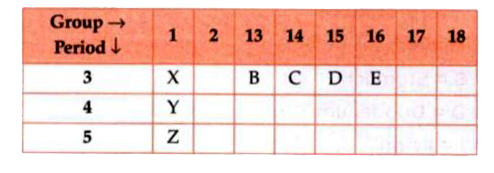Outermost electronic configuration of a group 13 element, E, is 4s2,4p1 . The electronic configuration of an element of p- block period – five placed diagonally to element , E is:
[Xe]5d106s26p2
[Xe]3d104s24p2
[Kr]3d104s24p2
[Kr]4d105s25p2
To solve the problem, we need to determine the electronic configuration of an element in the p-block of period 5 that is diagonally related to a group 13 element, E, with the given outermost electronic configuration of 4s24p1.
1. Identify the Group 13 Element:
The given electronic configuration for element E is 4s24p1. This corresponds to Gallium (Ga), which is the group 13 element in the fourth period.
2. Determine the Atomic Number of Gallium:
Gallium has an atomic number of 31. The electronic configuration can be confirmed as follows:
- 1s² 2s² 2p⁶ 3s² 3p⁶ 4s² 3d¹⁰ 4p¹.
3. Identify the Diagonal Relationship:
In the periodic table, the diagonal relationship typically refers to elements that are located diagonally across from each other in adjacent periods and groups. For group 13 (Ga), the diagonally related element in group 14 (the next group) is found in period 5.
4. Determine the Element in Period 5, Group 14:
The element in period 5, group 14, is Tin (Sn).
5. Write the Electronic Configuration of Tin:
The electronic configuration of Tin can be derived as follows:
- The atomic number of Tin is 50.
- Its electronic configuration is:
- 1s² 2s² 2p⁶ 3s² 3p⁶ 4s² 3d¹⁰ 4p⁶ 5s² 4d¹⁰ 5p².
- The outermost electronic configuration is 5s²5p².
Final Answer:
The electronic configuration of the element in the p-block period 5 placed diagonally to element E (Gallium) is 5s²5p².
The given electronic configuration for element E is 4s24p1. This corresponds to Gallium (Ga), which is the group 13 element in the fourth period.
Gallium has an atomic number of 31. The electronic configuration can be confirmed as follows:
- 1s² 2s² 2p⁶ 3s² 3p⁶ 4s² 3d¹⁰ 4p¹.
In the periodic table, the diagonal relationship typically refers to elements that are located diagonally across from each other in adjacent periods and groups. For group 13 (Ga), the diagonally related element in group 14 (the next group) is found in period 5.
The element in period 5, group 14, is Tin (Sn).
The electronic configuration of Tin can be derived as follows:
- The atomic number of Tin is 50.
- Its electronic configuration is:
- 1s² 2s² 2p⁶ 3s² 3p⁶ 4s² 3d¹⁰ 4p⁶ 5s² 4d¹⁰ 5p².
- The outermost electronic configuration is 5s²5p².
The electronic configuration of the element in the p-block period 5 placed diagonally to element E (Gallium) is 5s²5p².
Topper's Solved these Questions
- JEE MAINS 2021Book:JEE MAINS PREVIOUS YEARChapter:JEE MAINS 2021Exercise:CHEMISTRY (SECTION-A)
Explore 80 Videos
- JEE MAINS 2021Book:JEE MAINS PREVIOUS YEARChapter:JEE MAINS 2021Exercise:CHEMISTRY (SECTION-B)
Explore 40 Videos
- JEE MAINS 2021Book:JEE MAINS PREVIOUS YEARChapter:JEE MAINS 2021Exercise:CHEMISRY (SECTION-B)
Explore 9 Videos
- JEE MAINS 2020Book:JEE MAINS PREVIOUS YEARChapter:JEE MAINS 2020Exercise:CHEMSITRY
Explore 25 Videos
- JEE MAINS 2022Book:JEE MAINS PREVIOUS YEARChapter:JEE MAINS 2022Exercise:CHEMISTRY (SECTION-B)
Explore 10 Videos
Similar Questions
Knowledge Check

Write electronic configuration of element E.A2,8,3B2,8,6C2,8,5D2,8General electronic configuration of group 16 elements is
Ans2np3Bns2np4Cns2np2Dns2np5The outer electronic configuration of group VA elements is
Ans2np2Bns2np3Cns2np4Dns2np5
Give general electronic configuration of d-block elements.
View SolutionGeneral outer electronic configuration of f-block element is
View SolutionGeneral outer electronic configuration of d-block elements is,
View SolutionThe outermost electronic configuration of the least reactive element is
View SolutionThe most accepted electronic configuration of f-block element is
View Solution
